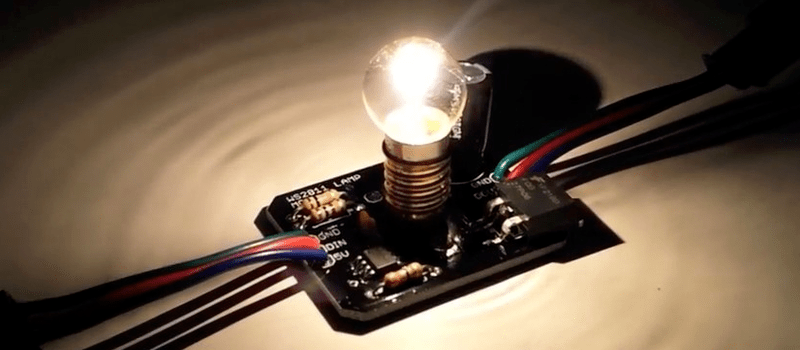What makes the WS2812-style individually addressable pixel LEDs so inviting? Their rich colors? Nope, you can get RGB LEDs anywhere. Their form factor? Nope. Even surface-mount RGBs are plentiful and cheap. The answer: it’s the integrated controller. It’s just so handy to speak an SPI-like protocol to your LEDs — it separates the power supply from the data, and you can chain them to your heart’s desire. Combine this controller and the LEDs together in a single package and you’ve got a runaway product success.
But before the WS2812, there was the WS2811 — a standalone RGB controller IC. With the WS2812s on the market, nobody wants the lowly WS2811’s anymore. Nobody except [Michael Krumpus], that is. You see, he likes the old-school glow of incandescent, but likes the way the WS2812 strings are easy to drive and extend. So he bought a bag of WS2811s and put the two together.
The controller IC can’t handle the current that an incandescent bulb requires, so he added a MOSFET to do the heavy lifting. After linking a few of these units together, he discovered (as one does with the LED-based WS2812s eventually) that the switching transients can pull down the power lines, so there is a beefy capacitor accompanying each bulb.
He wanted each bulb to be independently addressable, so he only used the blue line of the RGB controller, which leaves two outputs empty. I’m sure you can figure out something to do with them.
Needless to say, we’ve seen a lot of WS2812 hacks here. It’s hard to pick a favorite. [Mike] of “mike’s electric stuff” fame built what may be the largest installation we’ve seen, and this hack that effectively projection-maps onto a randomly placed string of WS2812s is pretty cool. But honestly, no project that blinks or glows can go far wrong, right?
















Nice work, nice work!
The filtering capacitor is needed because the effect is exaggerated with light bulbs: they are non linear, the resistance when it is cold is much much smaller than warm. Putting 1/255 PWM to it will probably not heat it up and end up burning a lot more than 1/255 of the max current.
The threshold may not be 1/255th, but keeping the bulbs on a tiny bit is something that was/is used in theater settings to keep the bulbs from burning out due to inrush current.
not sure if it is similar for all bulbs, but playing with a dimmer + energy monitor it shows regular mains incandescent need about 1/4 of max power before they start making any light.
Sure? Phase dimmers (TRIAC choppers) give very nonlinear results because of the sinusoidal nature of mains. At 1/4 duty you’re only talking about 1/6th Vrms.
I should probably rephrase my point as: Failing to turn the lights ever fully off, even if below the point of visible incandescence, would let him use a smaller bypass capacitor, because the resistance of the filament is proportional to temperature. Even with 500K of heating required before visible incandescence, sitting just sub-threshold (800K) will reduce inrush current by about a factor of 4 — http://hypertextbook.com/facts/2004/DeannaStewart.shtml
Er, not 1/6th Vrms. 1/20th Vrms. I know that sounded too good.
Hi, this is exactly what I need. Please, is it possible to buy a complete set of this solution somewhere?